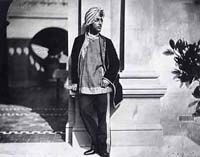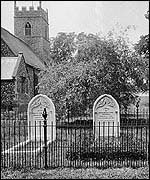Maharaja Dalip Singh Biography
Maharaja Dalip Singh, GCSI (6 September 1838, Lahore, Sikh Empire - 22 October 1893, Paris, France), commonly called Duleep Singh and later in life nicknamed the Black Prince of Perthshire, was the last Maharaja of the Sikh Empire. He was the youngest son of the legendary "Lion of the Punjab" Maharaja Ranjit Singh and Maharani Jind Kaur, and came to power after a series of intrigues, in which several other claimants to the throne and to the Koh-i-Noor diamond, killed each other. After his exile to Britain at age 13 following the British annexation of the Punjab, he was befriended by Queen Victoria. In June 1850, Lord Dalhousie presented the Kohinoor Diamond by Dalip Singh after it was confiscated by the British. From that date on, the diamond became part of the Crown Jewels, set in the Crown of Queen Elizabeth and on display in the Jewel House in the Tower of London.
Dalip Singh was much admired by Queen Victoria, who is reported to have written of the Punjabi maharajah "Those eyes and those teeth are too beautiful". The Queen was godmother to several of his children.

Today Singh is considered as Britain's first Sikh settler, having been exiled to its shores in 1854, after being dethroned and having his country annexed by the East India Company in 1849.
Early years
Dalip Singh was crowned to the throne of Punjab in 1843 succeeding his half-brother, Maharajah Sher Singh. After the close of the Second Anglo-Sikh War and the subsequent annexation of the Punjab on 29 March 1849, he was deposed at the age of eleven by the East India Company under Governor-General Hardinge and was separated from his mother, who was imprisoned. He was put into the care of Dr John Login and sent from Lahore to Fatehgarh on 21 December 1849.
The British took, in controversial circumstances, the Koh-i-Noor diamond along with other items of Dalip Singh's family's considerable personal estate, country and religious property (most items were sold by public auction) to Queen Victoria as reportedly part of the terms of the conclusion of the war and the 250th anniversary of the East India Company on 3 July 1850. His health was reportedly poor, and he was mostly in quasi-exile in Fatehgarh and Lucknow after 1849, with tight restrictions on who he was allowed to meet. No Indians, except trusted servants, could meet him in private. As a matter of British policy, he was to be anglicised in every possible respect. While no specific information was released about his health, he was often sent to the hill station of Landour near Mussoorie in the Lower Himalaya for convalescence, at the time about 4 days' journey. He would remain for weeks at a time in Landour at a grand hilltop building called The Castle, which had been lavishly furnished to accommodate him.
Legality of the Koh-i-noor being acquired by the British
The Kohinoor diamond was then given by Dalip Sing as Maharaja Ranjit Singh's successor (who owned it) to Queen Victoria, Indian historians argue that Prince Dalip Singh was only a minor then, and could not have given the diamond away without coercion from his British advisors. Record also says that the confiscated diamond was presented to the Queen-mother by Lord Dalhousie in 1850 through the young exiled Prince.

Conversion to Christianity
In 1853, under the tutelage of his long-time retainer Bhajan Lal (himself a Christian convert) he converted to Christianity at Fatehgarh with the approval of the Governor-General Lord Dalhousie. His conversion remains controversial, having been effected in unclear circumstances before he turned 15. He was also heavily and continuously exposed to Christian texts under the tutelage of the devout John Login. His two closest childhood friends were both English, one being the child of Anglican missionaries.
In 1854, he was sent into exile in Britain.
Life in exile
London
Dalip Singh's arrival on the shores of England in 1854 threw him into the European court. Queen Victoria showered affection upon the turbaned Maharajah, as did the Prince Consort. Dalip Singh was initially lodged at Claridge's Hotel in London before the East India Company took over a house in Wimbledon and then eventually another house in Roehampton which became his home for 3 years. He was also invited by the Queen to stay with the Royal Family at Osborne, where she sketched him playing with her children and Prince Albert photographed him, while the court artist, Winterhalter, made his portrait, He eventually got bored with Roehampton and expressed a wish to go back to India but it was suggested by the East India Company Board he take a tour of the European continent which he did with Sir John Spencer Login and Lady Login.
Scotland
On his return from Europe in 1855 he was given an annual pension, and was officially under ward of Sir John Spencer Login and Lady Login, who leased Castle Menzies in Perthshire, Scotland for him. He spent the rest of his teens there but at 19 he demanded to be in charge of his household. Eventually, he was given this and an increase in his annual pension. In 1858 the lease expired and Dalip Singh rented the house at Auchlyne from the Earl of Breadalbane. He was remarkable in the area as the first Indian prince to visit Scotland, and soon had the nickname, the "Black Prince of Perthshire". He was known for a lavish lifestyle, shooting parties, and a love of dressing in highland costume. (At the same time, he was known to have gradually developed a sense of regret for his circumstances in exile, including some inner turmoil about his conversion to Christianity and his forced departure from the Punjab). His mother stayed in Perthshire with him for a short time, before he rented the Grantully Estate, near Aberfeldy. Following the deaths of his mother and John Login in 1863, he returned to England.
Mulgrave Castle
Dalip Singh took on a lease at Mulgrave Castle in Yorkshire in 1858 and enjoyed the English countryside while there.
Elveden Estate
Dalip Singh bought (or the India Office purchased for him) a 17,000 acre (69 km²) country estate at Elveden on the border between Norfolk and Suffolk, close to Thetford, in 1863. He fell in love with Elveden and the surrounding area and restored the church, cottages, and school. He transformed the run-down estate into an efficient game preserve of approximately 17,000 acres (69 km2) and it was here that he gained his reputation as the fourth best shot in England. The house was re-modelled into a quasi-oriental palace where he lived the life of a British aristocrat. Dalip Singh was accused of running up large expenses and the estate was sold after his death to pay his debts. Today, Elveden is owned by descendants of the Guinness family of brewing fame; it remains an operating farm and private hunting estate.
Re-initiated into Sikhism
While in exile, he sought to learn more about Sikhism and was eager to return to India. Though previous efforts were thwarted by his handlers, he reestablished contact with his cousin Sardar Thakar Singh Sandhawalia, who on 28 September 1884, left Amritsar for England along with his sons Narinder Singh and Gurdit Singh and a Sikh granthi (priest), Pratap Singh Giani. He also brought a list of properties held by Dalip Singh in India, all this renewed his connection with Sikhism.
The British Government decided in 1886 against his return to India or his re-embracing Sikhism. Despite protests from the India Office, he set sail for 'home' on 30 March 1886. However, he was intercepted and arrested in Aden, where the writ of the Governor General of India began. He could not be stopped from an informal re-conversion ceremony in Aden, far less grand and symbolic than it would have been in India, done by emissaries sent by Sardar Thakar Singh Sandhawalia, who was earlier planning the Pahaul ceremony at Bombay. Dalip was forced to return to Europe.
Death
Dalip Singh died in Paris in 1893 at the age of 55, having seen India after the age of fifteen only during two brief, tightly-controlled visits in 1860 (to bring his mother to England) and in 1863 (to scatter his mother's ashes).

Dalip Singh's wish for his body to be returned to India was not honoured, in fear of unrest, given the symbolic value the funeral of the son of the Lion of the Punjab might have caused, given growing resentment of British rule. His body was brought back to be buried according to Christian rites, under the supervision of the India Office in Elveden Church beside the grave of his wife Maharani Bamba, and his son Prince Edward Albert Duleep Singh. The graves are located on the west side of the Church.
A life-size bronze statue of the Maharajah showing him on a horse was unveiled by HRH the Prince of Wales in 1999 at Butten Island in Thetford, a town which benefited from his and his sons' generosity. In an auction at Bonhams, London on 19 April 2007, the 74 cm high white marble portrait bust of Maharajah Duleep Singh by Victorian sculptor John Gibson RA in Rome in 1859 fetched £1.7 million (£1.5 million plus premium and tax).
